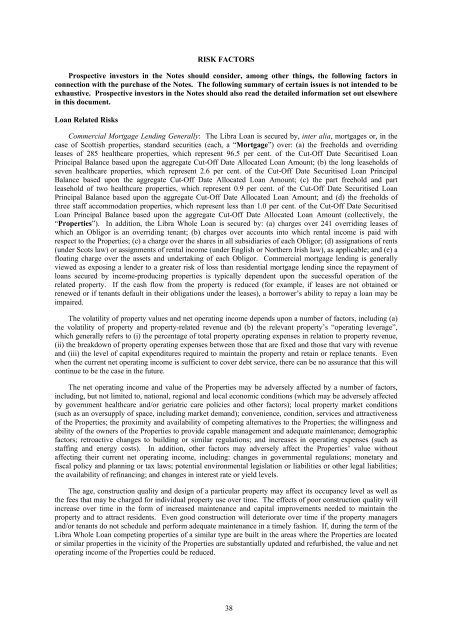Titan Europe 2007-1 (NHP) Limited - Irish Stock Exchange
Titan Europe 2007-1 (NHP) Limited - Irish Stock Exchange
Titan Europe 2007-1 (NHP) Limited - Irish Stock Exchange
You also want an ePaper? Increase the reach of your titles
YUMPU automatically turns print PDFs into web optimized ePapers that Google loves.
RISK FACTORS<br />
Prospective investors in the Notes should consider, among other things, the following factors in<br />
connection with the purchase of the Notes. The following summary of certain issues is not intended to be<br />
exhaustive. Prospective investors in the Notes should also read the detailed information set out elsewhere<br />
in this document.<br />
Loan Related Risks<br />
Commercial Mortgage Lending Generally: The Libra Loan is secured by, inter alia, mortgages or, in the<br />
case of Scottish properties, standard securities (each, a “Mortgage”) over: (a) the freeholds and overriding<br />
leases of 285 healthcare properties, which represent 96.5 per cent. of the Cut-Off Date Securitised Loan<br />
Principal Balance based upon the aggregate Cut-Off Date Allocated Loan Amount; (b) the long leaseholds of<br />
seven healthcare properties, which represent 2.6 per cent. of the Cut-Off Date Securitised Loan Principal<br />
Balance based upon the aggregate Cut-Off Date Allocated Loan Amount; (c) the part freehold and part<br />
leasehold of two healthcare properties, which represent 0.9 per cent. of the Cut-Off Date Securitised Loan<br />
Principal Balance based upon the aggregate Cut-Off Date Allocated Loan Amount; and (d) the freeholds of<br />
three staff accommodation properties, which represent less than 1.0 per cent. of the Cut-Off Date Securitised<br />
Loan Principal Balance based upon the aggregate Cut-Off Date Allocated Loan Amount (collectively, the<br />
“Properties”). In addition, the Libra Whole Loan is secured by: (a) charges over 241 overriding leases of<br />
which an Obligor is an overriding tenant; (b) charges over accounts into which rental income is paid with<br />
respect to the Properties; (c) a charge over the shares in all subsidiaries of each Obligor; (d) assignations of rents<br />
(under Scots law) or assignments of rental income (under English or Northern <strong>Irish</strong> law), as applicable; and (e) a<br />
floating charge over the assets and undertaking of each Obligor. Commercial mortgage lending is generally<br />
viewed as exposing a lender to a greater risk of loss than residential mortgage lending since the repayment of<br />
loans secured by income-producing properties is typically dependent upon the successful operation of the<br />
related property. If the cash flow from the property is reduced (for example, if leases are not obtained or<br />
renewed or if tenants default in their obligations under the leases), a borrower’s ability to repay a loan may be<br />
impaired.<br />
The volatility of property values and net operating income depends upon a number of factors, including (a)<br />
the volatility of property and property-related revenue and (b) the relevant property’s “operating leverage”,<br />
which generally refers to (i) the percentage of total property operating expenses in relation to property revenue,<br />
(ii) the breakdown of property operating expenses between those that are fixed and those that vary with revenue<br />
and (iii) the level of capital expenditures required to maintain the property and retain or replace tenants. Even<br />
when the current net operating income is sufficient to cover debt service, there can be no assurance that this will<br />
continue to be the case in the future.<br />
The net operating income and value of the Properties may be adversely affected by a number of factors,<br />
including, but not limited to, national, regional and local economic conditions (which may be adversely affected<br />
by government healthcare and/or geriatric care policies and other factors); local property market conditions<br />
(such as an oversupply of space, including market demand); convenience, condition, services and attractiveness<br />
of the Properties; the proximity and availability of competing alternatives to the Properties; the willingness and<br />
ability of the owners of the Properties to provide capable management and adequate maintenance; demographic<br />
factors; retroactive changes to building or similar regulations; and increases in operating expenses (such as<br />
staffing and energy costs). In addition, other factors may adversely affect the Properties’ value without<br />
affecting their current net operating income, including: changes in governmental regulations; monetary and<br />
fiscal policy and planning or tax laws; potential environmental legislation or liabilities or other legal liabilities;<br />
the availability of refinancing; and changes in interest rate or yield levels.<br />
The age, construction quality and design of a particular property may affect its occupancy level as well as<br />
the fees that may be charged for individual property use over time. The effects of poor construction quality will<br />
increase over time in the form of increased maintenance and capital improvements needed to maintain the<br />
property and to attract residents. Even good construction will deteriorate over time if the property managers<br />
and/or tenants do not schedule and perform adequate maintenance in a timely fashion. If, during the term of the<br />
Libra Whole Loan competing properties of a similar type are built in the areas where the Properties are located<br />
or similar properties in the vicinity of the Properties are substantially updated and refurbished, the value and net<br />
operating income of the Properties could be reduced.<br />
38

















